Grand Stade de Tanger (Stade Ibn Batouta) – until 2023
| Capacity | 65 000 |
|---|---|
| Country | Morocco |
| City | Tangier |
| Clubs | Ittihad de Tanger |
| Retire year | 2023 |
| Inauguration | 26/04/2011 |
| Construction | 09/2002 – 04/2011 |
| Renovations | 2020–2023 |
| Design | Jawad Khattabi (JK Architecture) |
| Cost | MAD 844 M ($91.5 M) |
Advertisement
Grand Stade de Tanger – historical stadium description
What was Grand Stade de Tanger (up to 2023) in brief?
The large, flagship stadium in Tangier was built in the early 21st century, with construction lasting nearly 10 years. The facility was equipped with an athletics track, but it was primarily used for football.
The stadium hosted matches of the Moroccan national team, club world championships, and games of the local team Ittihad Riadi de Tanger, which won the national championship in 2018.
Between 2020 and 2023, the first expansion took place, during which the stands on the curves were extended, increasing the capacity from 45,000 to 65,000 seats.
In the summer of 2023, the next phase of expansion began. The athletics track was removed, the stands were increased by an additional 10,000 seats (making the stadium the largest in the country, at least until the opening of Stade Hassan II), the facade was completed, and a new roof was added over the stands.
The expanded and modernized stadium gained a completely new look, becoming a high-standard, football-specific arena. Thanks to this transformation, it is set to host prestigious matches of the 2030 World Cup. The “new” Grand Stade de Tanger was inaugurated on 14 November 2025.
When was Grand Stade de Tanger built?
Construction of the large stadium in Tangier began in September 2002. However, the work was prolonged, and the facility was only completed in 2011. The total cost of the stadium amounted to 844 million dirhams, and the design was prepared by JK Architecture (lead architect Jawad Khattabi).
The new, much larger stadium replaced the old Stade de Marchan, which was located closer to the city center and could hold around 14,000 spectators. The old stadium was demolished a few years after the opening of the new venue, in 2016, and smaller training pitches and a playground were built in its place.
When was Grand Stade de Tanger inaugurated?
The inauguration took place on 26 April 2011, with two friendly matches played back-to-back: in the first, local side Ittihad Riadi de Tanger drew 1–1 with Atlético Madrid’s reserves, and then Atlético Madrid’s first team defeated Raja Casablanca 3–1.
What did Grand Stade de Tanger originally look like?
The stadium was built in an athletics layout, with a running track surrounded by stands. Along the pitch, the stands featured a high second tier, while the curves remained partially “open,” allowing for a potential future expansion with a second level.
The main stand (on the west side) was covered with a roof, and a video screen was installed on the southern curve. The stands, with seats in blue, grey, and yellow, were separated from the track by a deep ditch. The stadium had a capacity of 45,000 spectators, making it one of the largest in the country.
Where was Grand Stade de Tanger located?
The facility was built on the southwestern outskirts of the city, about 7 km from the center, along the main highway (N1) leading south and towards the airport.
What was around Grand Stade de Tanger?
The stadium was surrounded by a lot of open space, which was used to create an entire sports complex. Within a few years of the stadium’s opening, the area gained an Olympic swimming pool, a tennis complex, a multi-purpose sports hall, a smaller football stadium, a training track, and even a covered pétanque court.
What was the stadium in Tangier called?
The stadium was officially known as Grand Stade de Tanger (“Great Stadium of Tangier”), but it was also referred to as Stade Ibn Batouta, in honour of the greatest Arab traveller of the Middle Ages, who was born in Tangier.
What events took place at Grand Stade de Tanger?
Which team played its matches at Grand Stade de Tanger?
The stadium became the home of Tangier’s leading football club, Ittihad Riadi de Tanger. At the time of the stadium’s opening, the team competed in the second division, but in 2015 it was promoted to the top tier, and in the 2017/18 season it achieved a historic success by winning its first national championship.
What other competitions were held at Grand Stade de Tanger?
The stadium hosted numerous prestigious football events. Shortly after opening, on 27 July 2011, it staged the French Super Cup (Trophée des Champions), in which Olympique de Marseille defeated Lille OSC 5–4. The Trophée des Champions returned to Grand Stade de Tanger on 29 July 2017, when Paris Saint-Germain beat AS Monaco 2–1.
On 12 August 2018, the venue also hosted the Spanish Super Cup, witnessing FC Barcelona’s 2–1 victory over Sevilla FC.
The stadium served twice as one of the venues for the U-23 Africa Cup of Nations: during the inaugural edition in 2011 and again in 2023. In 2018, it hosted several matches of the African Nations Championship, a tournament featuring national teams composed solely of players from domestic leagues.
The venue was also scheduled to host matches of the 2015 Africa Cup of Nations, but Morocco withdrew from hosting due to the Ebola virus outbreak.
In February 2023, Grand Stade de Tanger hosted four of the seven matches (including the third-place game) of the Club World Cup. On occasion, the Moroccan national football team also played matches at the stadium.
How was Grand Stade de Tanger expanded?
What was the first phase of the Grand Stade de Tanger expansion?
In December 2020, the first major expansion of Grand Stade de Tanger began. The aim was to fill the “gaps” in the curves by adding a second tier of stands. This would create a continuous, oval structure of uniform height around the entire stadium. In addition, a decorative facade was planned for the exterior.
The expansion plans were prepared by Cabinet d'Architecture Amaoui Anouar Gueriri.
The work on the curves was completed by early 2023, just in time for the Club World Cup. The new facade was not yet fully finished at that time. Thanks to this expansion, the stadium’s capacity reached 65,000 spectators.
On the enlarged arena in February 2023, Club World Cup matches were held. On 26 March 2023, a prestigious friendly match took place, in which Morocco defeated Brazil 2–1. Between June and July 2023, the stadium hosted matches of the U-23 Africa Cup of Nations.
What did the second phase of the Grand Stade de Tanger expansion involve?
During the works, the stadium expansion concept was modified, and its scope was significantly increased. The additional tasks primarily included:
- Removing the athletics track, lowering the pitch, and constructing an additional tier of stands at the lower level, closest to the playing field. This would transform the stadium into a football-specific arena and increase its capacity to over 75,000 seats
- Installing a new roof covering all the stands
The stadium was also to be renovated and modernized, becoming a high-standard sports venue. Work on these tasks began in July 2023, with facade improvements continuing concurrently.
How was the Grand Stade de Tanger expansion linked to the 2030 World Cup?
The plans to convert the stadium into a football-specific arena were developed with the aim of hosting major international events. At the time, Morocco was bidding to host the 2025 Africa Cup of Nations and to co-host the 2030 World Cup.
Both bids were successful: on 27 September 2023, Morocco was announced as the host of the 2025 Africa Cup of Nations, and on 4 October 2023, the organization of the 2030 World Cup was awarded to the joint bid of Morocco, Spain, and Portugal (together with Argentina, Uruguay, and Paraguay, each hosting one match at the start of the tournament).
Thanks to these ambitious expansion plans, Grand Stade de Tanger was selected to host matches in both events, including prestigious World Cup fixtures.
When was the second phase of the Grand Stade de Tanger expansion carried out?
The second phase of the expansion, which began in the second half of 2023, continued until autumn 2025, with the stadium ready by mid-November 2025, just over a month before the start of the 2025 Africa Cup of Nations.
This phase gave the stadium a completely new look. The arena was transformed into a football-specific venue, and the decorative facade, full roof coverage, and renovated stands completely changed its appearance. With a capacity of over 75,000 spectators, the stadium became the largest in the country, although it is expected to be surpassed by the massive Stade Hassan II under construction near Casablanca.
The “new” Grand Stade de Tanger was inaugurated on 14 November 2025 with a friendly match between Morocco and Mozambique (1–0).
The “new” Grand Stade de Tanger, after the expansion completed at the end of 2025, is presented on a separate page
Advertisement
Pictures
2023
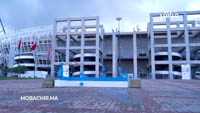
2023 © Mobachir 
2023 © Mobachir 
2023 © Mobachir 
2023 © Mobachir 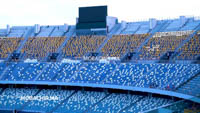
2023 © Mobachir 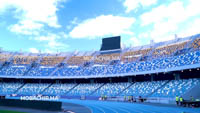
2023 © Mobachir 
2023 © Mobachir 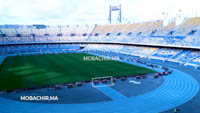
2023 © Mobachir 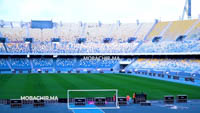
2023 © Mobachir 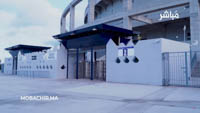
2023 © Mobachir 
2023 © Mobachir 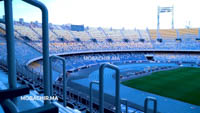
2023 © Mobachir 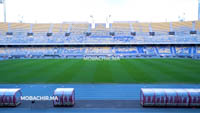
2023 © Mobachir 
2023 © Mobachir 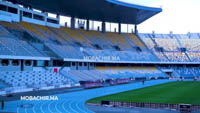
2023 © Mobachir
2013

08.12.2013 © Groundhopping Merseburg 
08.12.2013 © Groundhopping Merseburg 
08.12.2013 © Groundhopping Merseburg 
08.12.2013 © Groundhopping Merseburg 
08.12.2013 © Groundhopping Merseburg 
08.12.2013 © Groundhopping Merseburg 
08.12.2013 © Groundhopping Merseburg 
08.12.2013 © Groundhopping Merseburg 
08.12.2013 © Groundhopping Merseburg
Related news
2024
-

World Cup 2030: The race for the final (and more) enters decisive phase
Recent weeks have been tumultuous for the candidate cities, but the next few weeks will be a real storm. Of the 14 Spanish arenas aspiring to host the World Cup, only 11 will be chosen. Bernabéu, Camp Nou and Grand Stade de Casablanca are vying to host the finals, although the Moroccan megastadion exists only on paper for now.
-

World Stadiums Under Construction (April 2024)
Stadiums all over the world are still being built and we are constantly on top of things. This time, we will take you on a tour of all the major arena construction sites that will soon take their final shape. You will see as many as 15 sports venues, which are located on three continents.
2023
-

World Cup 2030: The list of venues that will host the tournament is clarifying
2030 FIFA World Cup will enter a higher level. After the event was played four years earlier on the territory of three different countries, the world football authorities have decided to organize the competition on three separate continents. Which venues will be on the list of host cities?
-

AFCON 2025: The race to host the tournament is picking up steam
After Guinea was stripped of its rights to host the AFCON in 2025, the African Football Confederation (CAF) had to restart procedures to select a host. As many as seven countries declared official interest in hosting the event. On December 16, the nations submitted their final bid.
 StadiumDB
StadiumDB